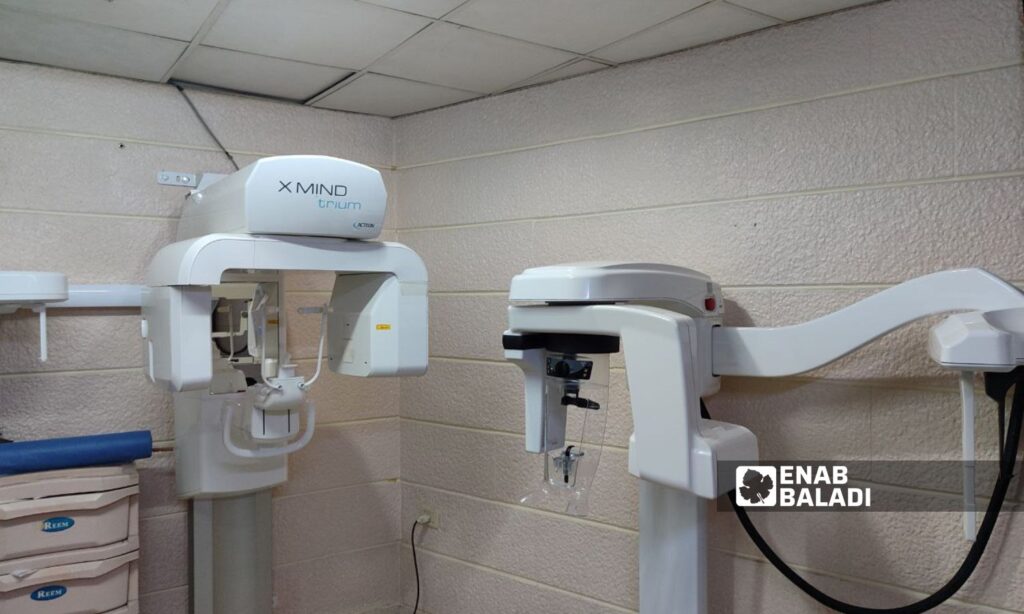Latakia – Linda Ali
Abbas, 41, a government employee, borrowed 500,000 Syrian pounds to be able to treat his father after he was plagued by knee pain and could no longer walk.
The orthopedist told him that his father needed to undergo X-ray imaging of the knees from multiple angles to determine the cause of the severe pain. When Abbas took his father to one of the radiography centers in the city of Latakia, he was surprised by the cost, which was 225,000 pounds. The center’s employee then asked him if he still wanted the image.
Abbas apologized to her and told her that he did not have the amount at that time. He returned home to secure the amount from a friend who lent him 250,000 pounds and returned to get the image, which revealed that his father suffered from severe inflammation that would require him to take many medicines and injections and continue treatment for a whole year. If he does not respond, he will need to undergo joint replacement surgery at a cost exceeding 70 million pounds.
Abbas said that he was completely stunned by the high cost of radiography. The nurse justified the high price to him by the electricity cuts and their reliance on expensive fuel sold in the black market, in addition to the high prices of films and imaging supplies.
Abbas will not be able to easily secure the amount he borrowed, which amounts to 500,000 pounds, each 250,000 of which is from a different friend. The family will need to sell a jerry can of oil from their rations to pay off the debts and complete the treatment, as the price of one injection exceeded 75,000 pounds, and he needs it every 15 days until visiting the doctor after a month to decide whether to continue the treatment or switch to another treatment depending on the body’s response.
The amount is high compared to the living and economic situation in Latakia and throughout Syria, as the average government salaries in the areas under the control of the Syrian regime do not exceed 186,000 pounds (one dollar is equivalent to about 14,500 pounds).
800,000 pounds for an MRI
At the end of October 2022, Elham, 46, suffered from dizziness and numbness in her left foot and hand, which raised her concerns and prompted her to visit the doctor, who informed her of the necessity of undergoing an urgent magnetic resonance imaging (MRI) to determine the cause.
Elham applied for free imaging at the government Maternity and Children Hospital in Latakia and was given an appointment after two and a half months due to the high workload, but her condition could not tolerate the delay.
The woman headed to a private center in the city, where she was surprised that the cost of the imaging she needed was 800,000 pounds, an amount she could never dream of possessing, as her salary does not exceed 250,000 pounds, as she works in one of the city’s private kitchens.
Elham was forced to resort to fraud to solve the issue and agreed with the employee at the center to use her sister’s employee health insurance card in exchange for giving him 50,000 pounds. He agreed to her request, and she started the procedures to submit a request for approval of the imaging. The insurance company responded to the request two days after submission, and Elham paid 10% of the value of the MRI image (about 80,000 pounds) in addition to the 50,000 pounds she provided to the employee at the center.
Radiography fees are significantly high in Syria in general, making a visit to radiography centers a heavy burden for those in need. For example, the cost of imaging a foot to determine if there is a fracture is about 170,000 pounds, and the panoramic image of the jaw reaches about 180,000 pounds, depending on its type and the number of areas to be imaged within the mouth.
Despite the presence of radiography services in many government hospitals in Latakia, the problem lies in the high demand and the patient’s need to wait a long time to complete the imaging, while some cases are urgent and cannot tolerate delays.
Government hospitals do not provide patients with a printed image, and after great effort, the center’s employee may provide them with the image on a CD or flash drive at best.
The medical sector in Syria is facing several problems, including a shortage of care, medical staff, and services provided, as well as an increasing emigration of doctors to different countries, in addition to the high fees for medical examinations and their variation between one region and another, and the high prices of medications.

